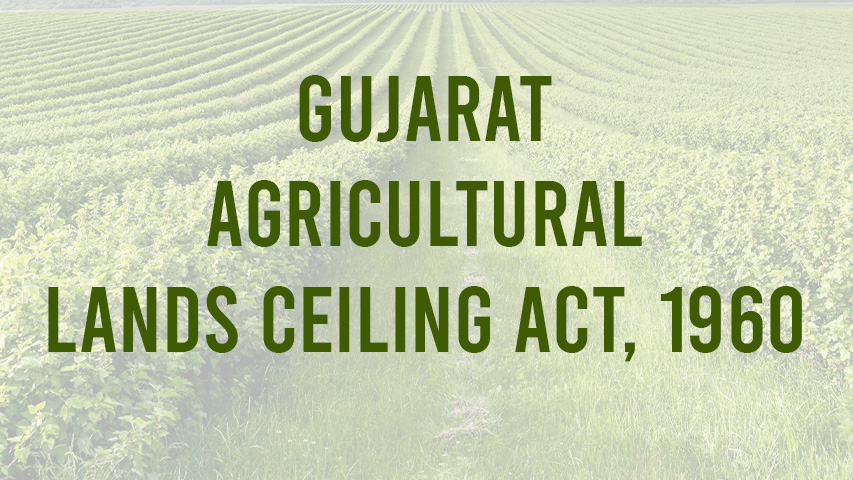
The Gujarat Agricultural Lands Ceiling Act, 1960, is a significant legal framework that is intended to reform and regulate land ownership in the Indian state of Gujarat. Enacted to address the issue of unequal land distribution and tenancy in agricultural lands, this legislation aimed to promote social justice, enhance productivity, and ensure economic stability. This article will delve into the implications of the Gujarat Agricultural Lands Ceiling Act, analyzing its historical context, objectives, implementation challenges, and its impact on the agricultural sector.
Contents
1. Historical Context
2. Objectives of the Act
3. Implementation Challenges
4. Impact on the Agricultural Sector
2. Objectives of the Act
3. Implementation Challenges
4. Impact on the Agricultural Sector
5. End Note
Historical Context
The enactment of the Gujarat Agricultural Lands Ceiling Act, 1960, was influenced by widespread concerns about the concentration of agricultural land in the hands of a few wealthy individuals, leaving small and marginal farmers struggling for subsistence. Before the Act, rampant land accumulation resulted in social disparities, economic exploitation, and limited agricultural productivity. Recognizing the need for reform, the Gujarat government introduced this legislation to ensure equitable land distribution and to support the welfare of marginalized farmers.
Objectives of the Act
The primary objectives of the Gujarat Agricultural Lands Ceiling Act, 1960, were to break up large landholdings and distribute surplus land amongst landless laborers and marginal farmers, empowering them socioeconomically. The Act aimed to limit the ownership of agricultural land by an individual or a family to a specific ceiling. This was done to create a landholding structure that promoted productivity, reduced inequalities, and improved rural development.
Implementation Challenges
While the Gujarat Agricultural Lands Ceiling Act, 1960, had noble intentions, its implementation faced several challenges that hindered its ability to achieve the desired outcomes. Firstly, the Act was opposed by influential landowners who were reluctant to surrender their excess land. This resistance often led to legal battles, and delays, and undermined the principles of the legislation.
Secondly, proper identification and measurement of surplus land proved to be a complex and time-consuming task. Detailed surveys were required to determine the boundaries and extent of excess land holdings. Lack of adequate resources, technical expertise, and logistical constraints further hampered the efficient implementation of the Act.
Thirdly, the redistribution of surplus land to landless laborers and marginal farmers faced challenges in terms of administration, financial support, and beneficiary identification. Inadequate support infrastructure and limited access to credit and agricultural inputs hindered the effective utilization of redistributed land, resulting in restricted productivity gains.
Impact on the Agricultural Sector
The Gujarat Agricultural Lands Ceiling Act, 1960, had a mixed impact on the agricultural sector in the state. On one hand, the Act led to the redistribution of surplus land, providing an opportunity for socio-economic upliftment and securing livelihoods for marginalized farmers. It helped in reducing economic disparities, promoting social inclusivity, and fostering rural development.
On the other hand, the Act faced limitations due to challenges in implementation. Large-scale land redistribution often resulted in fragmented ownership, leading to small and unviable landholding sizes. This restrained the potential for increased agricultural productivity and limited the scope for mechanization, modernization, and technological advancements in farming practices.
Furthermore, the Act faced criticism for neglecting the issue of land consolidation, which could have facilitated the creation of larger landholdings and allowed for efficient farming practices. The lack of consolidation hindered economies of scale, making it difficult for small farmers to compete in the market and restricting agricultural growth.
Potential Benefits of the Act
| Benefit | Description |
|---|---|
| Land Redistribution | The act aims to redistribute surplus land to landless and marginalized farmers, providing them with access to agricultural land. |
| Enhanced Agricultural Productivity | By redistributing land, the act intends to increase agricultural productivity as more people will have access to land for cultivation. This can lead to increased food production, higher income for farmers, and improved rural development. |
| Preventing Land Concentration | The act puts a limit on the maximum amount of agricultural land that an individual or family can own. This prevents land concentration in the hands of a few wealthy individuals or entities, promoting a more balanced distribution of land resources. |
| Social Justice | The act aims to achieve social justice by providing land to landless farmers, scheduled castes, scheduled tribes, and other disadvantaged groups. |
| Environmental Conservation | Through the act, the government can identify and preserve ecologically sensitive areas as well as protect agriculture land from non-agricultural uses. This ensures the conservation of rural landscapes and natural resources. |
End Note
The Gujarat Agricultural Lands Ceiling Act, 1960, was a groundbreaking legislation aimed at ensuring equitable land distribution, reducing social and economic inequalities, and promoting rural development. It had a profound impact on the agricultural sector in Gujarat, with positive impacts on marginalized farmers. However, the Act also encountered implementation challenges that limited its full potential. To address these limitations, it is essential to focus on efficient implementation strategies, invest in rural infrastructure development, provide access to modern farming techniques and credit facilities, and strike a balance between land redistribution and consolidation to maximize the benefits for all stakeholders involved in the agricultural sector.
